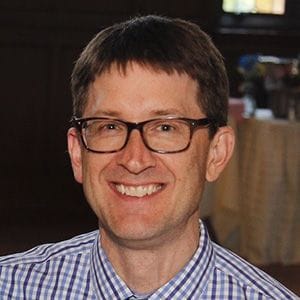In this interview, Prof. McCamant describes his current research and shares his recent experience with publishing under an ACS read and publish agreement.

As part of an ongoing series here on ACS Axial, we’re interviewing authors and librarians from around the world to find out more about their research, their published work, and the impact that open science is having on a changing landscape of research communication. This time, we talked with David W. McCamant, Associate Professor at the University of Rochester.
It seems fantastic that scientific work can be made generally available to everybody on Earth.

Hello, Prof. McCamant—could you tell us a little about yourself and your current research focus?
I lead the McCamant Group at the University of Rochester, working on ultra-fast laser spectroscopy. Right now, we're focused on molecules that are useful for solar energy: molecules that absorb light and are efficient at doing electron transfer out of the excited state. You can use those electrons to generate solar energy, or solar fuels if you catalyze reactions with those electrons.
You published a paper with ACS in early 2024, "The Best Models of Bodipy’s Electronic Excited State: Comparing Predictions from Various DFT Functionals with Measurements from Femtosecond Stimulated Raman Spectroscopy." How would you summarize that for someone unfamiliar with the area?
This was an interesting piece of research. I had a graduate student, Juan Sandoval—lead author on the paper—who is a former theoretician and is really quite good at general theoretical treatments. We were trying to model some of our results with electronic structure calculations, and he realized that it was really difficult to choose the proper functionals when you're using time-dependent density-functional theory (TDDFT) to model your results. The results really matter depending on what feels like very small or random choices that you're making about how you run these calculations.
We were looking at BODIPY, which is a strongly absorbing dye that's used in a lot of fluorescence assays and some solar energy work. It's a very popular organic dye that absorbs strongly in the middle of the visible spectrum. And a broad interest of the group, separate from any direct application, is how molecules change their structure when they absorb light—you excite an electron from an occupied orbital into an unoccupied orbital. That change in electronic structure can cause geometry changes in the molecule; some bonds stretch, some bonds contract, and there's lots of twisting that goes on when you make that electronic excitation. TDDFT is one of the approaches you can use to understand what's going on in the excited state, but all the different functionals give you really different results that can be very confusing. We realized that through Resonance Raman spectroscopy experiments we could get data that could be used to test different TDDFT functionals with, and so that by comparing Resonance Raman intensity with predictions from the TDDFT, we could say which functionals were reasonable and which ones were giving very unreasonable descriptions of the excited state. So it's really a way to vet which functionals you're using when you're choosing a theoretical method.
Your article was published in The Journal of Physical Chemistry A. How was the experience?
It was great. I really like the ACS journals and JPC; the editors work really hard to make sure that the whole peer review process operates efficiently. We got really good reviews on the article, and so it went through pretty easily, and the whole process was quite straightforward. I enjoyed it for sure.
What kind of impact do you think your paper has had so far?
It's a relatively recent paper; it only came out last month, so it's perhaps a bit too early to say.
The article was published under your institution's read and publish agreement with ACS—how did you find out that this was available?
Our librarian, Sue Cardinal, mentioned it to us, and that really made open access possible. Scientists have really been squeezed in the past few years because research funding didn't really cover the cost of open access publishing fees. I'm invested in the idea of open access, as are many other researchers, but we really didn't have the funds to do it. We were really dependent on our institution's open access agreement with the American Chemical Society that allowed us to publish open access in JPC, and the process was super straightforward: just click a button during submission. Whatever's happening on the back end of the process is very seamless in terms of recognizing that our institution had that agreement, and setting up the forms for us to sign.
From a corresponding author's point of view, the publishing process was no problem at all. The ACS submission system identified that based on my affiliation, I had access to the agreement. I just needed to confirm that I wanted to publish open access, and then one day later I got an email confirming that the publishing fees were paid—the process was very clear, and very fast.
What are your thoughts on open access?
I definitely like the idea of open access. It seems fantastic that scientific work can be made generally available to everybody on Earth. That's a fantastic idea, and manifests some of the best things about the idea of the Internet. The main issue is that funding for publishing articles is super expensive…how in the world do we pay for them if there's not a subscription fee? So that transition from institutions paying large subscription fees in the past to institutions being able to pay for open access agreements has been very difficult. Maybe we've started to make that transition, but I feel that funding agencies have not been helpful at all. All the funding agencies in the US—the National Science Foundation, NIH, and so on—are really are pushing for open access for all publications which makes sense. Absolutely the government should be making the science that they fund available to taxpayers. But there's no budget for it— so for instance, I'm submitting a grant proposal in the next month, and we have enough spare after we pay our graduate students to pay for one open access article. That's all we can afford in the grant. So that's really where we are: as researchers get squeezed at the grant level, that's where the open access agreements really help.
What are your thoughts on open science more generally?
I've only explored these a little bit, but open peer review is a really interesting idea. I feel like I would like to have open comments on articles. But peer review is often a very critical process, and that's reasonable that in some cases it would be private. I don't think that we really need to make all the initial criticisms of the first draft of something generally available - we all have bad first drafts from time to time, and we don't need to publish that.
I have explored open data a little bit, but we haven't really dived into that exactly. We certainly share data with people that ask for it, and what I would like to do in its simplest form would be to make our published data downloadable directly alongside the paper. That would be a really nice thing to have, so that people when they see Figure 3, they can download the data in Figure 3 and replot it in any different ways that they're curious about, so they can analyze it themselves. A lot of the open data initiatives seem to focus more on transparency about the whole data collection process from the beginning of the experiment to the end, but I don't think that will always work. In my experience, most people doing that have been social scientists, and in the hard sciences we just generate way too much bad data: in many cases experiments simply don't work, so all that garbage being on a public-facing website would not really help anyone. We need to do a lot of calibration and analysis before we get anything that's really worth sharing.
Where do you see the open science movement in 10 years' time?
I hope that we can transition to a system where all publications coming out of scientific research groups are open access. That would be the very basic thing that I hope we're on the path towards; hopefully within 10 years we will have sorted out the funding to make sure that that can happen. It shouldn't be a difficult and expensive choice that researchers have to make, it should be something that is just included in funding—but I haven't seen any movement from research funders. Maybe I'm out of the loop, but as far as I can tell, there's no movement there and we're just expected to cut researchers to free up funds for publication. Instead of hiring an undergraduate for the summer, we could use that money to pay for an open access fee, which really seems like a counterproductive funding trade for the sciences.
Hopefully, that side of this will get fixed up—research funders will find specific line items where they are happy to put in coverage for appropriate fees and raise budget ceilings accordingly. Really, I think that what has to happen is that funders have to be happy to kick in another $10,000 for a grant to pay for the open access that they're asking for.
Finally—what do you think you'd be doing if you weren't a researcher?
I'm really not sure! I think about that question a lot, actually, and I really have no idea. I've always really liked art, and I really like bicycles, so maybe I could make a living doing something in one of those fields.
Check out the other interviews in this series:
Professor Ian Cousins, Stockholm University
Hongxia Duan, TU Eindhoven
Vojtěch Vaněček, Institute of Physics, Czech Academy of Sciences
Louise Otting, TU Delft
Kristine Horvat, University of New Haven
Fernando Sartillo Piscil, Benemérita Universidad Autónoma de Puebla
Lillian Chong, University of Pittsburgh
Sue Cardinal, University of Rochester
Rubén Mendoza-Cruz, Universidad Nacional Autónoma de México
Alison Bradley, Partnership for Academic Library Collaboration and Innovation
Vesna Srot, Max Planck Institute for Solid State Research
Matt McDowell, Georgia Institute of Technology